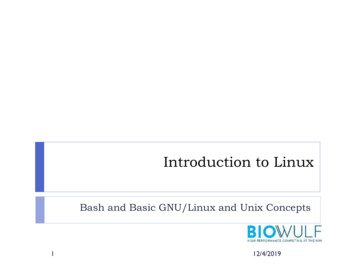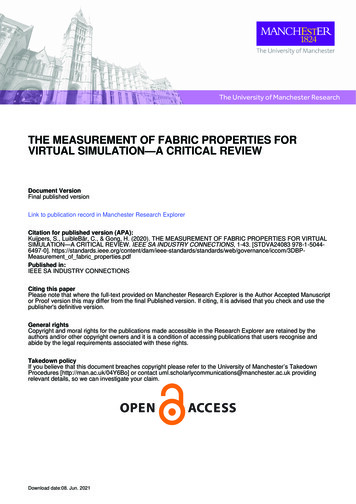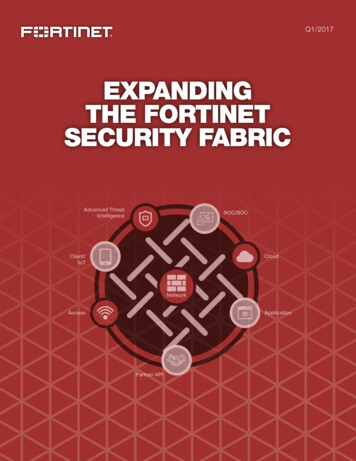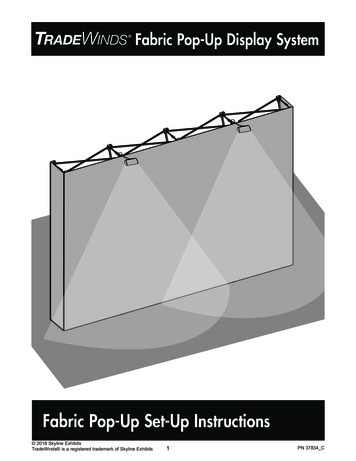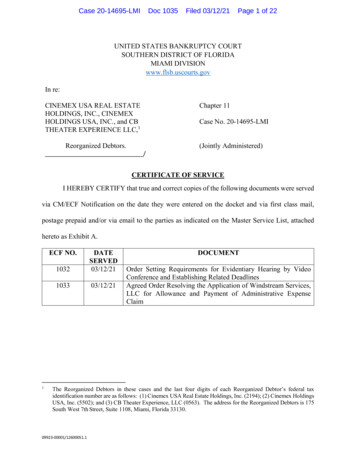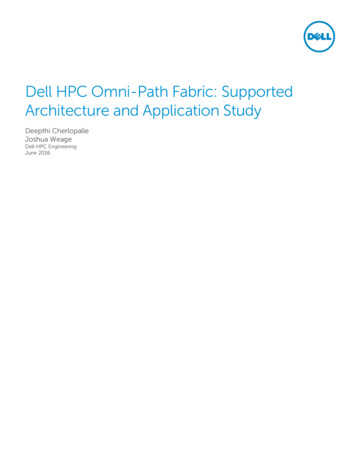
Transcription
Dell HPC Omni-Path Fabric: SupportedArchitecture and Application StudyDeepthi CherlopalleJoshua WeageDell HPC EngineeringJune 2016
RevisionsDateDescriptionJune 2016Initial release – v1THIS WHITE PAPER IS FOR INFORMATIONAL PURPOSES ONLY, AND MAY CONTAIN TYPOGRAPHICAL ERRORS AND TECHNICAL INACCURACIES.THE CONTENT IS PROVIDED AS IS, WITHOUT EXPRESS OR IMPLIED WARRANTIES OF ANY KIND.Copyright 2016 Dell Inc. All rights reserved. Dell and the Dell logo are trademarks of Dell Inc. in the United States and/or other jurisdictions. Allother marks and names mentioned herein may be trademarks of their respective companies.2Dell HPC Omni-Path Fabric: Supported Architecture and Application StudyJune 2016
Table of contentsRevisions . 2Executive Summary . 5Audience . 51Introduction . 72Dell Networking H-Series Fabric. 92.1Intel Omni-Path Host Fabric Interface (HFI) . 92.1.1 Server Support Matrix . 92.2Dell H-Series Switches based on Intel Omni-Path Architecture. 92.2.1 Dell H-Series Edge Switches . 102.2.2 Dell H-Series Director-Class Switches . 113Intel Omni-Path Fabric Software . 123.1Available Installation Packages . 123.1.1 Supported Operating Systems . 123.1.2 Operating System Prerequisites . 123.2Intel Omni-Path Fabric Manager GUI . 133.2.1 Overview of Fabric Manager GUI . 133.3Chassis Viewer . 143.4OPA FastFabric. 153.4.1 Chassis setup . 153.4.2 Switch setup . 153.4.3 Host Setup . 153.5Fabric Manager . 153.5.1 Embedded Subnet Manager. 163.5.2 Host-Based Fabric Manager . 1734Test bed and configuration . 185Performance Benchmarking Results . 205.1Latency . 205.2Bandwidth . 205.3Weather Research Forecast . 215.4NAMD . 225.5ANSYS Fluent . 225.6CD-adapco STAR-CCM . 246Conclusion and Future Work . 267References . 27Dell HPC Omni-Path Fabric: Supported Architecture and Application StudyJune 2016
List of FiguresFigure 1Figure 2Figure 3Figure 4Figure 5Figure 6Figure 7Figure 8Figure 9Figure 10Figure 11Figure 12Figure 13Figure 14Figure 15Figure 16Figure 17Intel Omni-Path Host Fabric Interface Adapter 100 series 1 port PCIe x16 .9Dell H-Series Switches .10Dell H1024-OPF Edge Switch .10H1048-OPF Edge Switch .10H9106-OPF (left) and H9124-OPF (right) Director-Class Switches . 11Intel Omni-Path Fabric Suite Fabric Manager Home page overview . 13Intel Omni-Path Chassis Viewer Overview . 14Fastfabric Tools . 15Starting Embedded Subnet Manager . 17OSU Latency values based on Intel Xeon CPU E5-2697 v4 processor . 20OSU Bandwidth values based on Intel Xeon CPU E5-2697 v4 processor. . 21Weather Research Forecasting model performance graph . 21NAMD performance graph. 22ANSYS Fluent Relative Performance Graph (1/2) . 23ANSYS Fluent Relative Performance (2/2) . 23STAR-CCM Relative Performance Graph (1/2) . 24STAR-CCM Relative Performance (2/2) . 25List of tablesTable 1Table 24Server Configuration . 18Application and benchmarks Details . 19Dell HPC Omni-Path Fabric: Supported Architecture and Application StudyJune 2016
Executive SummaryIn the world of High Performance Computing (HPC), servers with high-speed interconnects play a key role in the pursuitto achieve exascale performance. Intel’s Omni-Path Architecture (OPA) is the latest addition to the interconnect universeand is a part of Intel Scalable System framework. It is based on innovations from Intel’s True Scale technology, Cray’sAries interconnect, internal Intel IP and from several other open source platforms. This paper provides an overview ofthe OPA technology, its features, Dell’s support and walks through the OPA software ecosystem. It dwells into theperformance aspects of OPA ranging from micro benchmarks to many commonly used HPC applications (bothproprietary and open source) at a 32 node ( 900 core) scale. To summarize the experience, the learning curve for OPAwasn’t steep because of its roots in True Scale architecture and it satisfies the low latency and high bandwidthrequirements needed for HPC applications.A big thank you to our team members Nishanth Dandapanthula, Alex Filby and Munira Hussain for their day-to-dayeffort assisting with the setup and configurations necessary for this paper, and we would like to thank James Erwin fromIntel who has been helping us through our journey with Omni-Path.AudienceThis document is intended for people who are interested in learning about the key features and application performanceof the new Intel Omni-Path Fabric technology.5Dell HPC Omni-Path Fabric: Supported Architecture and Application StudyJune 2016
6Dell HPC Omni-Path Fabric: Supported Architecture and Application StudyJune 2016
1IntroductionThe High Performance Computing (HPC) domain primarily deals with problems which surpass thecapabilities of a standalone machine. With the advent of parallel programming, applications can scale pasta single server. High performance interconnects provide low latency and high bandwidth which are neededfor the application to divide the computational problem among multiple nodes, distribute data and thenmerge partial results from each node to a final result. As the computation power increases with greaternumber of nodes/cores added to the cluster configuration, the need for efficient and fast communicationhas become essential to continue to improve system performance. Applications may be sensitive tothroughput and/or latency capabilities of the interconnect depending upon their communicationcharacteristics.Intel Omni-Path Architecture (OPA) is an evolution of Intel True Scale Fabric Cray Aries interconnect [1]and internal Intel IP. In contrast to Intel True Scale Fabric edge switches that support 36 ports of InfiniBandQDR-40Gbps performance, the new Intel Omni-Path fabric edge switches support 48 ports of 100Gbpsperformance. The switching latency for True Scale edge switches is 165ns-175ns. The switching latency forthe 48-port Omni-Path edge switch has been reduced to around 100ns-110ns. The Omni-Path Host FabricInterface (HFI) MPI messaging rate is expected to be around 160 Million messages per second (Mmps) anda link bandwidth of 100Gbps.The OPA technology includes a rich feature set. A few of those are described here [1]:Dynamic Lane Scaling: When one or more physical lanes fail, the fabric continues to function with theremaining available lanes and the recovery process is transparent to the user and application. This allowsjobs to continue and provides the flexibility of troubleshooting errors at a later time.Adaptive Routing: This monitors the routing paths of all the fabrics connected to the switch and selects theleast congested path to balance the workload. This implementation is based on the cooperation betweenApplication-specific integrated circuits (ASIC) and Fabric Manger. The Fabric Manager performs the role ofinitializing the fabrics and setting up routing tables, once this is done the ASICs actively monitor and managethe routing by identifying fabric congestion. This feature helps the fabric to scale.Dispersive Routing: Initializing and configuring the routes between the neighboring nodes of the fabric isalways critical. Dispersive routing distributes the traffic across multiple paths as opposed to sending themto the destination via a single path. It helps to achieve maximum communication performance for theworkload and promotes optimal fabric efficiency.Traffic Flow Optimization: Helps in prioritizing packets in mixed traffic environments like storage and MPI.This helps to ensure that the high priority packets will not be delayed and there will be less/no latencyvariation on the MPI job. Traffic can also be shaped during run time by using congestion control and adaptiverouting.Software Ecosystem: It leverages the Open Fabric Alliance (OFA) [2] and uses a next generation PerformanceScaled Messaging (PSM) layer called PSM2 which supports extreme scale but is still compatible with previousgeneration PSM applications. OPA also includes a software suite with extensive capabilities for monitoringand managing the fabric.On-load and Offload Model: Intel Omni-Path can support both on-load and offload models depending onthe data characteristics. There are two methods of sending data from one host to another.7Dell HPC Omni-Path Fabric: Supported Architecture and Application StudyJune 2016
Sending the data Programmed I/O (PIO): This supports the on-load model. The host can be used to send smallmessages since these can be sent by the CPU faster than an RDMA setup time.Send DMA (SDMA): For larger messages the CPU sets up a RDMA send and then the 16 SDMA enginesin the HFI transfer the data to the receiving host without CPU intervention.Receiving the data Eager receive: The data is delivered to the host memory and then copied to the application memory.This protocol is faster for smaller messages and does not require any responsesExpected Receive: Data flows directly from HFI to application memory without CPU intervention.Each data transfer method is independent. For example, SDMA can be used from Sender’s side and Eagerreceive method can be used on the other side. This can be used for medium size messages since it doesnot require full RDMA setup. However, the packet size threshold for small, medium and large have defaultvalues but are configurable.All these features make OPA an ideal component for HPC workloads. In the upcoming sections, this whitepaper details Dell’s support of Intel OPA and dives deeper into the software ecosystem. Finally, it discussesthe performance characterization of several HPC workloads at scale using OPA.8Dell HPC Omni-Path Fabric: Supported Architecture and Application StudyJune 2016
2Dell Networking H-Series FabricDell Networking H-Series Fabric is a comprehensive fabric solution that includes host adapters, edge anddirector class switches, cabling and complete software and management tools.2.1Intel Omni-Path Host Fabric Interface (HFI)Dell provides support for Intel Omni-Path HFI 100 series cards [3] which are PCIe Gen3 x16 and capable of100Gbps per port. Each Intel Omni-Path HFI card has 4 lanes supporting 25Gbps each and can deliver upto 25GBps bidirectional bandwidth per port. Intel OPA supports QSFP28 quad small form factor withpluggable passive and optical cables.Figure 12.1.1Intel Omni-Path Host Fabric Interface Adapter 100 series 1 port PCIe x16Server Support MatrixThe following Dell servers support Intel Omni-Path Host Fabric Interface cards 2.2PowerEdge R430PowerEdge R630PowerEdge R730PowerEdge R730XDPowerEdge R930PowerEdge C4130PowerEdge C6320PowerEdge FC830Dell H-Series Switches based on Intel Omni-Path ArchitectureDell networking provides H-series Edge and Director Class switches which are based on the Intel OmniPath architecture and are targeted for HPC environments ranging from small to large scale clusters.9Dell HPC Omni-Path Fabric: Supported Architecture and Application StudyJune 2016
Figure 2 Dell H-Series Switches2.2.1Dell H-Series Edge SwitchesDell H-Series Edge Switches based on the Intel Omni-Path Architecture consist of two models supporting100Gbps for all ports: an entry-level 24-port switch targeting entry-level/small clusters and a 48-port switchwhich can be combined with other edge switches and directors to build larger clusters.Figure 3Dell H1024-OPF Edge SwitchFigure 4H1048-OPF Edge SwitchA complete description and specifications for these switches can be found on the Dell Networking H-SeriesEdge Switches product page.10Dell HPC Omni-Path Fabric: Supported Architecture and Application StudyJune 2016
2.2.2Dell H-Series Director-Class SwitchesDell H-Series Director-Class Switches based on the Intel Omni-Path Architecture consist of two modelssupporting 100Gbps for all ports: a 192-port switch and a 768-port switch. These switches support HPCclusters of all sizes, from mid-level clusters to supercomputers.Figure 5H9106-OPF (left) and H9124-OPF (right) Director-Class SwitchesA complete description and specifications for these switches can be found on the Dell Networking H-SeriesDirector-Class Switches product page.11Dell HPC Omni-Path Fabric: Supported Architecture and Application StudyJune 2016
3Intel Omni-Path Fabric Software3.1Available Installation PackagesThe following packages [4] are available for an Intel Omni-Path Fabric: 3.1.1Intel Omni-Path Fabric Host Software – This is the basic installation package that provides Intel Omni-Path Fabric Host components needed to set up compute, I/O and service nodes with drivers,stacks and basic tools for local configuration and monitoring. This package is usually installed oncompute-nodes.Intel Omni-Path Fabric Suite (IFS) Software – This package installs all the components that areincluded in basic and adds additional fabric management tools like FastFabric and Fabric Manager.Intel Omni-Path Fabric Suite Fabric Manger GUI – This package can be used to monitor and manageone or more fabrics and it can be installed on a computer outside of the fabric.Supported Operating SystemsThe following list of o
Figure 6 Intel Omni-Path Fabric Suite Fabric Manager Home page overview . Executive Summary In the world of High Performance Computing (HPC), servers with high-speed interconnects play a key role in the pursuit to achieve exascale performance. Intel’s Omni-Path Architecture
